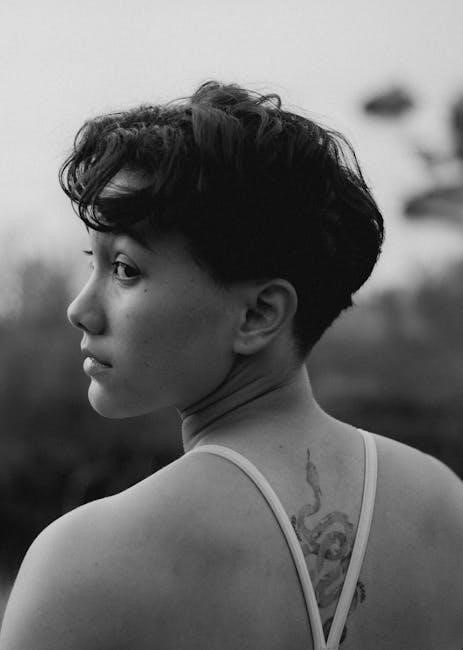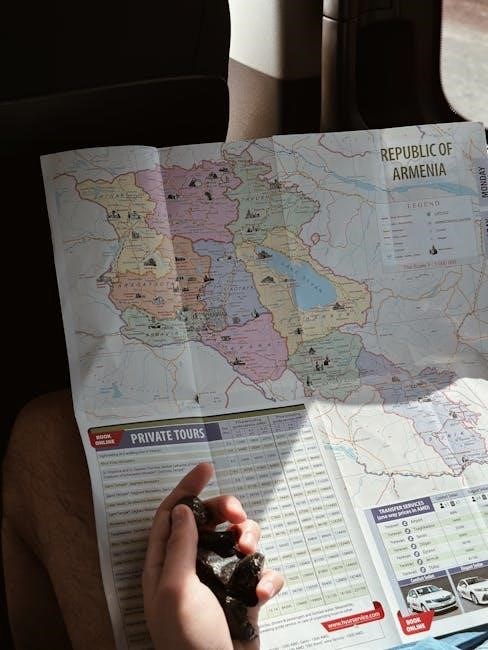
tattoo location guide
Tattoo placement is crucial for both aesthetic appeal and personal expression, determining how a design complements the body. It involves considering factors like size, shape, and visibility to ensure the tattoo aligns with individual style and lifestyle needs.
Importance of Tattoo Location
The location of a tattoo significantly impacts its visual appeal and personal significance. Different body areas offer unique opportunities for design expression, with some spots enhancing the art’s beauty while others provide discreetness. The placement influences how the tattoo interacts with the body’s natural curves and lines, making it essential to choose a spot that complements both the design and personal style. Additionally, visibility and pain tolerance are critical factors, as certain areas are more sensitive or noticeable than others. Ultimately, the right location ensures the tattoo aligns with the wearer’s lifestyle, preferences, and long-term goals, making it a meaningful and lasting form of self-expression.
Key Factors to Consider When Choosing a Tattoo Spot
Choosing the right tattoo spot involves evaluating several key factors to ensure the best outcome. Pain tolerance is a primary concern, as areas with less fat or closer to bone, like the ribs or feet, are more painful. The design size and complexity also matter, with larger pieces requiring ample space, such as the back or chest. Visibility is another consideration; some prefer discreet placements like the forearm or thigh, while others opt for bold, visible spots like the arm or shoulder. Additionally, body type and personal style play a role, as certain areas complement specific physiques or aesthetic preferences. Ultimately, the spot should align with the individual’s lifestyle and design goals for a satisfying result.

Popular Tattoo Placement Areas
Popular tattoo placement areas include arms, legs, chest, back, and shoulders. These spots are favored for their visibility and versatility, accommodating various tattoo designs and styles seamlessly.
Chest and Abdomen Tattoos
The chest and abdomen are popular areas for tattoos, offering a canvas for both bold and intricate designs. The chest is ideal for heart, eagle, or symbolic tattoos, while the abdomen suits smaller, delicate art. These areas allow for creativity, with the chest often used for personal or meaningful designs. Pain levels vary, with the chest being moderate and the abdomen less painful due to more flesh. Visibility can be controlled, as clothing easily covers these spots. Both areas are versatile, making them suitable for various tattoo styles and preferences, ensuring a balance between aesthetics and personal expression.
Back and Shoulder Tattoos
The back and shoulders are highly popular tattoo locations, offering ample space for intricate or large-scale designs. The upper back is ideal for detailed artwork, while the shoulders provide a more compact canvas. These areas are versatile, accommodating various styles, from symbolic motifs to elaborate scenes. Pain levels are moderate, as the flesh is thicker, though the lower back can be more sensitive. Tattoos here are easily hidden, making them practical for professional settings. The back and shoulders also enhance muscle definition, making them a favorite for athletic body types. Their symmetry and visibility make them a sought-after choice for bold, statement-making designs that hold deep personal or aesthetic significance.
Arm and Forearm Tattoos
Arm and forearm tattoos are highly versatile, offering both visibility and the option for discretion. The upper arm is ideal for bold designs that can be easily covered, while the forearm provides a canvas for intricate details and personal symbolism. These areas are popular for first-time tattoos due to their moderate pain levels and aesthetic appeal. Sleek designs on the forearm can complement the natural shape of the arm, making them flattering for various body types. Additionally, the arm allows for easy concealment, making it a practical choice for those who prefer hidden ink. Its versatility and visibility make it a timeless favorite for both subtle and statement-making tattoos.
Leg and Thigh Tattoos
Leg and thigh tattoos are popular for their versatility and aesthetic appeal. The thigh, with its ample space, is ideal for detailed, large-scale designs, while the leg offers a sleek canvas for bold or delicate patterns. These areas are less painful compared to bony regions, making them a great choice for those with lower pain tolerance. The thigh also provides a private spot for discreet tattoos, easily hidden when desired; Legs are perfect for showcasing flowing designs that wrap around the limb, creating a dynamic visual effect. Whether you prefer subtle symbols or elaborate artwork, the leg and thigh offer a versatile and attractive placement for self-expression.
Hand and Finger Tattoos
Hand and finger tattoos are unique and highly visible, making them a bold choice for self-expression. These areas are ideal for small, intricate designs, such as symbols, letters, or minimalist patterns. Finger tattoos can mimic rings, adding a personal touch, while palms or wrists offer space for slightly larger designs. However, these areas are more painful due to their proximity to bone and nerve endings. Visibility is a key consideration, as hand tattoos are difficult to hide, making them less suitable for professional or conservative settings. Despite the challenges, they remain popular for their edgy appeal and ability to convey personal meaning in a striking way.
Foot and Ankle Tattoos
Foot and ankle tattoos are a subtle yet striking form of self-expression, offering a delicate way to showcase personal style. These areas are ideal for small, detailed designs, such as minimalist symbols or dainty patterns, due to their limited space. Ankle tattoos, in particular, are popular for their elegance and versatility, often blending seamlessly with jewelry or clothing. Foot tattoos, while similar, tend to be more hidden, making them a discreet choice. However, these areas can be more painful due to their bony structure and thin skin. Despite this, their unique placement makes them a meaningful way to add a personal touch to one’s body art collection.
Neck and Head Tattoos
Neck and head tattoos are bold and visible, making them powerful statement pieces. These areas are ideal for those who embrace individuality and want their art to stand out. The nape of the neck, behind the ear, and sides of the head are popular spots, often featuring delicate patterns or symbolic designs. Due to their visibility, these tattoos can carry significant cultural or personal meaning, often symbolizing spirituality, rebellion, or identity. However, the neck and head areas are sensitive, and the process can be painful. Despite this, many find the aesthetic and emotional impact well worth the discomfort, making these locations a compelling choice for those seeking a striking, unforgettable tattoo.

Less Conventional Tattoo Locations
Less conventional tattoo spots, such as ribs, spine, behind the ear, and wrist, offer unique canvas opportunities for those seeking distinctive, eye-catching designs that stand out.
Ribs and Side Tattoos
Ribs and side tattoos are popular for their unique aesthetic and ability to showcase intricate designs. The ribcage offers a flat, expansive area ideal for detailed artwork, while the sides provide a sleek, curved canvas. These spots are perfect for flowing patterns, quotes, or symbolic imagery, as the natural contours enhance visual appeal. However, tattooing on the ribs can be painful due to the proximity to bone and limited flesh. Despite the discomfort, many find the result rewarding, especially for personal, meaningful designs. Proper aftercare is crucial to ensure healing and maintain the tattoo’s vibrancy. This placement is great for those seeking a striking yet non-traditional look.
Spine and Lower Back Tattoos

Spine and lower back tattoos are highly popular for their elegance and symbolic appeal. The spine offers a narrow, elongated space, ideal for delicate lines, names, or small symbols, while the lower back provides a broader canvas for intricate designs. These areas are often chosen for their aesthetic appeal and ability to be easily concealed or revealed. However, tattooing near the spine can be quite painful due to the proximity to bone and nerve endings. Despite the discomfort, many appreciate the unique beauty and personal significance of these placements, making them a popular choice for meaningful or decorative body art.
Behind the Ear and Hairline Tattoos
Behind the ear and hairline tattoos are subtle yet striking, offering a discreet way to showcase personal art. These areas are ideal for small, delicate designs, such as symbols, names, or minimalist patterns. The space behind the ear is particularly popular for its ability to be easily hidden or revealed, making it a great choice for those seeking a low-profile tattoo. Hairline tattoos, while less common, can blend seamlessly with natural hair, creating a unique aesthetic. However, these placements may require regular touch-ups due to hair growth and friction. Despite the potential maintenance, these spots remain favored for their elegance and personal significance.
Wrist and Elbow Tattoos
Wrist and elbow tattoos are popular for their versatility and visual appeal. The wrist is a subtle yet trendy spot, often chosen for small, delicate designs like symbols or minimalist patterns. It’s ideal for those seeking a discreet tattoo that can be easily concealed. Elbow tattoos, while less common, offer a unique canvas for bold or intricate art. Both areas are great for personal symbolism, such as strength or resilience. However, the elbow can be more painful due to its bony structure. Proper aftercare is essential for these spots, as they are prone to friction and sun exposure. Simple designs work best for long-term durability.

Tattoo Placement for Specific Designs
Tattoo placement depends on the design’s size, detail, and intended visibility. Small, delicate designs thrive in subtle spots, while larger pieces require spacious areas for maximum impact and clarity. Personal significance often dictates placement, ensuring the tattoo resonates with its owner. Visibility preferences also influence location choices, balancing aesthetics with lifestyle needs. Each design finds its ideal home through thoughtful consideration of these factors.
Small Tattoos: Best Placement Options
Small tattoos are ideal for delicate designs, thriving in areas like the wrist, ankle, or behind the ear. These spots offer subtle visibility while maintaining aesthetic appeal. The forearm or upper thigh also provides a discreet yet stylish canvas for minimalistic designs. For those seeking hidden ink, the back of the neck, ribcage, or top of the foot are excellent choices. Small tattoos are perfect for first-time ink enthusiasts, as they are less painful and easier to conceal. Their compact size allows for versatility, ensuring the design complements the body without overwhelming it. This makes them a popular choice for meaningful yet understated personal expression.
Large Tattoos: Ideal Body Areas
Large tattoos are best suited for areas offering ample space, such as the back, chest, or thighs. These regions provide a expansive canvas for intricate designs, allowing the artwork to breathe and maintain clarity; The arms and legs are also popular, as they naturally showcase bold, flowing patterns. For a striking visual impact, the upper back and shoulders are ideal, as they highlight muscle definition. The abdomen and ribcage can also accommodate large designs, though they may be more painful due to proximity to bone and less fatty tissue. Large tattoos are a great way to make a bold statement, ensuring the design is both visible and visually stunning.
Symbolic Tattoos: Meaningful Placement
Symbolic tattoos thrive in placements that resonate with their intended meaning. The wrist or forearm is ideal for personal symbols, serving as constant reminders. For deeper significance, consider the chest or back of the neck, where designs can be hidden or revealed. The spine is a powerful spot for symbols representing strength or growth, visually aligning with the body’s vertical axis. Small symbols, like stars or birds, work well on the ankle or behind the ear for subtlety. Placement should reflect the tattoo’s emotional weight, ensuring it becomes a meaningful part of your personal story and identity.

Pain Considerations for Tattoo Placement
Tattoo pain varies by location, with areas like ribs, spine, and feet being particularly sensitive due to proximity to bone and nerve endings. Forearms and upper thighs are generally less painful.
High Pain Areas: Ribs, Spine, and Feet
Tattooing on the ribs, spine, and feet is known to be particularly painful due to their proximity to bone and nerve endings. The ribcage has limited flesh, making it sensitive, while the spine’s thin skin near the vertebrae increases discomfort. Feet, with their numerous nerve endings, are also highly sensitive. These areas require careful consideration and often involve taking breaks during sessions. While pain tolerance varies, these spots are consistently ranked as high pain zones. Proper preparation and aftercare are essential for managing discomfort in these challenging locations.
Low to Moderate Pain Areas: Forearms and Upper Thighs
Forearms and upper thighs are considered low to moderate pain areas for tattoos due to their muscle density and distance from bone. These areas offer ample space for detailed designs and are popular for first-time tattoos. The forearm is ideal for script or floral patterns, while the upper thigh provides a larger canvas for intricate art. Pain levels are manageable, making these spots great for longer sessions. Their versatility and relatively lower discomfort make forearms and upper thighs favored choices for those seeking a balance between aesthetics and comfort.

Tattoo Visibility and Lifestyle
Tattoo visibility impacts lifestyle choices, with discreet placements like upper arms or thighs for hidden ink and bold statement spots like ankles or fingers for visibility.
Hidden Tattoos: Discreet Placement Ideas
For those seeking discreet tattoos, placement is key to maintaining privacy while still expressing personal style. Areas like the upper arm, back, thighs, and ribcage are ideal, as they can be easily covered with clothing. The forearm is another popular choice for small, subtle designs. Calves and ankles also offer versatility, allowing tattoos to remain hidden when needed. These spots are perfect for individuals who want to keep their ink private or professional. Opting for smaller, simpler designs in these areas ensures the tattoo remains understated yet meaningful. This approach balances personal expression with practicality, making it easier to conceal when desired.
Visible Tattoos: Bold and Statement-Making Spots
For those who embrace their tattoos as a form of self-expression, visible placements offer a bold and eye-catching way to showcase body art. Areas like the chest, back, shoulders, and arms provide ample space for intricate designs, making them ideal for large, striking pieces. The forearm is particularly popular for bold lines and vibrant colors, while the chest and back allow for sprawling designs that make a strong visual impact. These spots are perfect for individuals who want their tattoos to be a focal point, reflecting their personality and style. Visible tattoos are a confident choice for those who embrace their art and want it to stand out.

Tattoo Placement for Different Body Types
Tattoo placement should complement your body shape. Slim frames benefit from curved designs on arms or legs, while athletic builds enhance muscle definition with bold shoulder or back tattoos.
Slim Body Types: Flattering Placement Options
For individuals with slim body types, certain tattoo placements enhance their natural physique. The arms, legs, and collarbone areas are ideal for showcasing intricate or minimalist designs. These spots provide a clean canvas, allowing tattoos to stand out without overwhelming the frame. Delicate designs on the forearm or ankle can add elegance, while subtle neck or shoulder tattoos create a refined look. Slimmer bodies also benefit from vertical placements, such as along the spine or ribcage, which elongate the silhouette. When choosing a design, consider its size and style to ensure it complements your body’s proportions and personal aesthetic;
Athletic Body Types: Enhancing Muscle Definition
For individuals with athletic body types, tattoo placement can accentuate muscle definition and create a dynamic visual impact. The biceps, triceps, and shoulders are ideal spots, as they naturally showcase strength and form. Larger designs on the back or thighs can complement muscular structure, while smaller, precise tattoos on the calves or forearms add a subtle yet striking touch. Bold lines and shading can enhance the muscular contours, creating a harmonious balance between art and physique. Choosing designs that align with the body’s natural lines ensures a cohesive and visually appealing result that highlights athletic build and personal style.

Cultural and Personal Significance of Tattoo Placement
Tattoo placement often reflects cultural heritage and personal journeys, with symbolic designs placed in meaningful areas to convey identity, spirituality, or life experiences, making each tattoo uniquely profound.
Cultural Influences on Tattoo Location
Cultural background significantly influences tattoo placement, with various traditions favoring specific body areas. In many Asian cultures, tattoos on the back or shoulders are common, symbolizing strength and spirituality. Tribal communities often opt for arms or torsos to display heritage designs. Western societies lean toward visible placements like arms or shoulders for self-expression. Some cultures prefer discreet locations, such as the ribs or upper back, to honor privacy. Additionally, symbolic meanings tied to certain body parts guide placement decisions, ensuring tattoos align with cultural values and personal identity. These practices highlight how cultural heritage shapes the art of tattoo placement.
Personal Meaning: Placing Tattoos in Significant Areas
Personal meaning plays a vital role in choosing tattoo locations, as it allows individuals to connect deeply with their body art. Many opt for areas that hold emotional significance, such as the chest for heart-related designs or the forearm for personal mantras. Others choose spots tied to life milestones, like the back for a meaningful journey or the wrist for a symbolic reminder. Some prefer hidden areas, such as behind the ear or on the ribcage, to keep their tattoos private yet meaningful. The placement becomes an extension of their story, ensuring the tattoo resonates with their identity and experiences, making it truly personal and impactful.

Future Trends in Tattoo Placement
Future trends in tattoo placement emphasize minimalistic designs and smaller, discreet tattoos. Subtle placements on wrists, ankles, and behind the ears are gaining popularity, reflecting personalization and individuality.
Emerging Trends in Body Art Placement
Emerging trends in body art placement highlight minimalistic designs and smaller tattoos in discreet locations. Many individuals now opt for subtle placements on wrists, ankles, and behind the ears, emphasizing personalization. These areas allow for unique expression while maintaining a low-profile appearance. Cultural influences also play a role, with symbolic tattoos placed in meaningful spots to resonate with individual identities. The focus is shifting toward balance—tattoos that are visually striking yet easily concealable. This trend reflects a desire for art that complements the body naturally, blending aesthetics with personal significance. As body art evolves, these innovative placements continue to redefine self-expression.